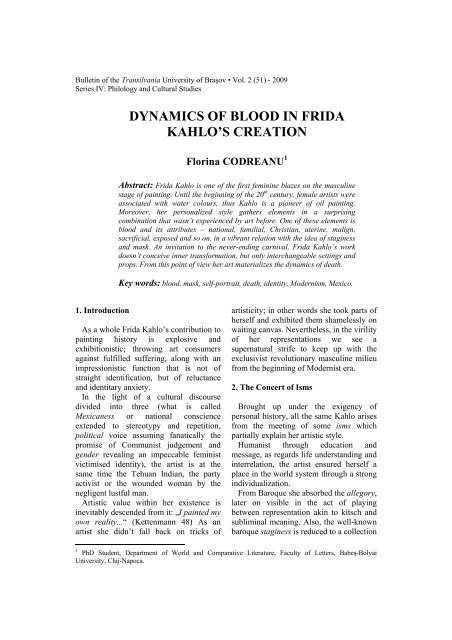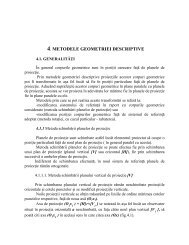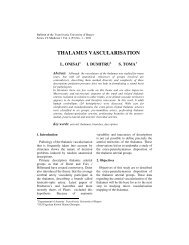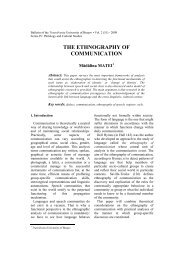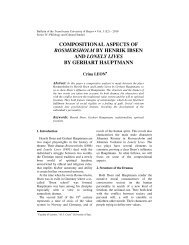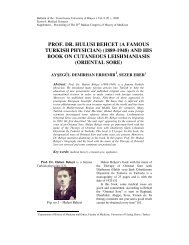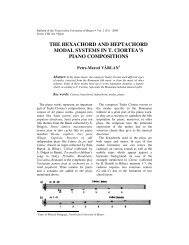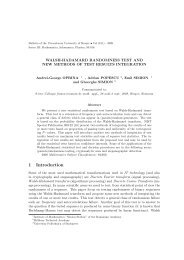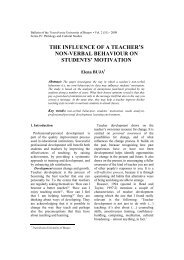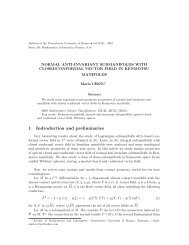Codreanu, F.: Dynamics of Blood in Frida Kahlo's Creation
Codreanu, F.: Dynamics of Blood in Frida Kahlo's Creation
Codreanu, F.: Dynamics of Blood in Frida Kahlo's Creation
You also want an ePaper? Increase the reach of your titles
YUMPU automatically turns print PDFs into web optimized ePapers that Google loves.
Bullet<strong>in</strong> <strong>of</strong> the Transilvania University <strong>of</strong> Braşov • Vol. 2 (51) - 2009Series IV: Philology and Cultural StudiesDYNAMICS OF BLOOD IN FRIDAKAHLO’S CREATIONFlor<strong>in</strong>a CODREANU 1Abstract: <strong>Frida</strong> Kahlo is one <strong>of</strong> the first fem<strong>in</strong><strong>in</strong>e blazes on the mascul<strong>in</strong>estage <strong>of</strong> pa<strong>in</strong>t<strong>in</strong>g. Until the beg<strong>in</strong>n<strong>in</strong>g <strong>of</strong> the 20 th century, female artists wereassociated with water colours, thus Kahlo is a pioneer <strong>of</strong> oil pa<strong>in</strong>t<strong>in</strong>g.Moreover, her personalized style gathers elements <strong>in</strong> a surpris<strong>in</strong>gcomb<strong>in</strong>ation that wasn’t experienced by art before. One <strong>of</strong> these elements isblood and its attributes – national, familial, Christian, uter<strong>in</strong>e, malign,sacrificial, exposed and so on, <strong>in</strong> a vibrant relation with the idea <strong>of</strong> stag<strong>in</strong>essand mask. An <strong>in</strong>vitation to the never-end<strong>in</strong>g carnival, <strong>Frida</strong> Kahlo’s workdoesn’t conceive <strong>in</strong>ner transformation, but only <strong>in</strong>terchangeable sett<strong>in</strong>gs andprops. From this po<strong>in</strong>t <strong>of</strong> view her art materializes the dynamics <strong>of</strong> death.Key words: blood, mask, self-portrait, death, identity, Modernism, Mexico.1. IntroductionAs a whole <strong>Frida</strong> Kahlo’s contribution topa<strong>in</strong>t<strong>in</strong>g history is explosive andexhibitionistic; throw<strong>in</strong>g art consumersaga<strong>in</strong>st fulfilled suffer<strong>in</strong>g, along with animpressionistic function that is not <strong>of</strong>straight identification, but <strong>of</strong> reluctanceand identitary anxiety.In the light <strong>of</strong> a cultural discoursedivided <strong>in</strong>to three (what is calledMexicaness or national conscienceextended to stereotypy and repetition,political voice assum<strong>in</strong>g fanatically thepromise <strong>of</strong> Communist judgement andgender reveal<strong>in</strong>g an impeccable fem<strong>in</strong>istvictimised identity), the artist is at thesame time the Tehuan Indian, the partyactivist or the wounded woman by thenegligent lustful man.Artistic value with<strong>in</strong> her existence is<strong>in</strong>evitably descended from it: „I pa<strong>in</strong>ted myown reality...“ (Kettenmann 48) As anartist she didn’t fall back on tricks <strong>of</strong>artisticity; <strong>in</strong> other words she took parts <strong>of</strong>herself and exhibited them shamelessly onwait<strong>in</strong>g canvas. Nevertheless, <strong>in</strong> the virility<strong>of</strong> her representations we see asupernatural strife to keep up with theexclusivist revolutionary mascul<strong>in</strong>e milieufrom the beg<strong>in</strong>n<strong>in</strong>g <strong>of</strong> Modernist era.2. The Concert <strong>of</strong> IsmsBrought up under the exigency <strong>of</strong>personal history, all the same Kahlo arisesfrom the meet<strong>in</strong>g <strong>of</strong> some isms whichpartially expla<strong>in</strong> her artistic style.Humanist through education andmessage, as regards life understand<strong>in</strong>g and<strong>in</strong>terrelation, the artist ensured herself aplace <strong>in</strong> the world system through a strong<strong>in</strong>dividualization.From Baroque she absorbed the allegory,later on visible <strong>in</strong> the act <strong>of</strong> play<strong>in</strong>gbetween representation ak<strong>in</strong> to kitsch andsublim<strong>in</strong>al mean<strong>in</strong>g. Also, the well-knownbaroque stag<strong>in</strong>ess is reduced to a collection1 PhD Student, Department <strong>of</strong> World and Comparative Literature, Faculty <strong>of</strong> Letters, Babeş-BolyaiUniversity, Cluj-Napoca.
250Bullet<strong>in</strong> <strong>of</strong> the Transilvania University <strong>of</strong> Braşov • Vol. 2 (51) - 2009 • Series IV<strong>of</strong> masks. For that matter mask<strong>in</strong>g isexpressed clearly by an impressive number<strong>of</strong> self-portraits <strong>in</strong> which motion andgestures are denied from the start. Actionis illustrated only symbolically, either as amanifesto, or as a pr<strong>in</strong>ciple, never asmotion itself. Therefore, <strong>Frida</strong>’s universe,despite its bold exteriorization, is actuallyclosed, without hope, sp<strong>in</strong>n<strong>in</strong>g the neverend<strong>in</strong>gvicious cycle <strong>of</strong> disease, surgeries,<strong>in</strong>fections and corsets. To malignrepeatability she reacts defensively with asort <strong>of</strong> evanescent titanic behaviour(excessive attitude, parties, bisexuality,alcohol and narcotics).Predilection for portrait bares uptight<strong>in</strong>ertness caused by suffer<strong>in</strong>g, which canbe neither overcome, nor ignored. Pa<strong>in</strong>seduction is too powerful, and the viewerwatch<strong>in</strong>g her pa<strong>in</strong>t<strong>in</strong>g is isolated <strong>in</strong> thesame contemplation with the artist.Moreover, dramatism is just a pose,manipulat<strong>in</strong>g the spectator by an appeal tohis emotions and reward<strong>in</strong>g him, <strong>in</strong> theend, with the revelation <strong>of</strong> the ma<strong>in</strong>character: the otherness that suffers fromcentrality. Whether there is or nottransformation <strong>in</strong> <strong>Frida</strong> Kahlo’s artrepresents the stake for the present study.In the 19 th century the Realistconventions and standards discard wasissued and the mirror-like worldrepresentation took over. The future artistprecociously felt the world as it is throughpoliomyelitis. The disease acted as acatalyst for an <strong>in</strong>valided dissimilarcategory: she is go<strong>in</strong>g to be identified bythe children <strong>in</strong> the suburb as peg-leg <strong>Frida</strong>(pata de palo). Later on, her creation is tore-embrace the world <strong>in</strong> the mirror throughnudity elements, anti-capitalist attitude andvirulent social critique. The relevance <strong>of</strong>emotional and social order stands at thecentre <strong>of</strong> her artistic vision that proliferates<strong>in</strong> accordance with beauty denial andemphasis on contiguous materialism. Allthe way it macerates the same suffer<strong>in</strong>g,chang<strong>in</strong>g only the sett<strong>in</strong>gs.Dur<strong>in</strong>g Modernism, the cultural agesynchronous to the biography underconsideration, there is a relation <strong>of</strong> partialsynonymy between <strong>Frida</strong> and experimentalart, seek<strong>in</strong>g solutions not only for artexpression, but also for surviv<strong>in</strong>g. Thebackground consists <strong>in</strong> deep radicalism:challeng<strong>in</strong>g the whole human body andlist<strong>in</strong>g carefully all the deformities <strong>of</strong><strong>in</strong>dustry and <strong>in</strong>ternationalism 1 .The designation <strong>of</strong> artistic vision asdom<strong>in</strong>ant religion meant a concomitantrejection <strong>of</strong> what is <strong>of</strong> <strong>in</strong>dustrial orig<strong>in</strong>.Accord<strong>in</strong>gly, the artist <strong>in</strong>itiated a valuation<strong>of</strong> primitivism, po<strong>in</strong>t<strong>in</strong>g out anethnographic <strong>in</strong>terest for Mexican traditionand for the vigour <strong>of</strong> Aztec legacy <strong>in</strong> terms<strong>of</strong> encourag<strong>in</strong>g the reproductive quality <strong>of</strong>art. The civilization kept alive byproliferat<strong>in</strong>g technical ramifications,smoke, wires or pipes contrasts with thesimplicity and emotional charge <strong>of</strong> thenon-occidental archaic realm, the cycle <strong>of</strong>nature and the regenerat<strong>in</strong>g strength <strong>of</strong> theland. Anyone would say: a voluntary<strong>in</strong>solent simplification, impregnated withdark humour and punitive opprobrium!Reach<strong>in</strong>g the p<strong>in</strong>nacle <strong>of</strong> her creativeexpression, she is wooed by Surrealismthrough Breton’s mediation: „The art <strong>of</strong><strong>Frida</strong> Kahlo is a ribbon around a bomb“(Burrus 66), be<strong>in</strong>g assigned to Surrealistirrational and subversive matter when as amatter <strong>of</strong> fact <strong>Frida</strong>’s pa<strong>in</strong>t<strong>in</strong>g istremendously studied. The so-calledrepressed creativity, sub-consciousness parexcellence, is actually sought, hunted forits redeem<strong>in</strong>g value. However what drew<strong>Frida</strong> close to the Surrealists are herhumour palpitat<strong>in</strong>g <strong>of</strong> anti-bourgeois socialfervour and her ambivalent attitude,sometimes highly negative, towardswomen: not to be forgotten her virileportraits, blessed with thick eyebrows,
<strong>Codreanu</strong>, F.: <strong>Dynamics</strong> <strong>of</strong> <strong>Blood</strong> <strong>in</strong> <strong>Frida</strong> Kahlo’s <strong>Creation</strong> 251moustache and constant endurance <strong>of</strong>traits!A f<strong>in</strong>al historic contract is legalised withthe Social Realism hav<strong>in</strong>g as subscribers:critique, justice, class-fight<strong>in</strong>g anddeclamation <strong>of</strong> <strong>in</strong>convenient truths, such asunconcealed ugl<strong>in</strong>ess. There is a chopperpressure to look attractive and on thatscore chopp<strong>in</strong>g a woman’s hair is viewedas a fem<strong>in</strong>ist manifesto: See, if I loved you,it was for your hair; now that you’re bald,I don’t love you any more 2 .3. Becom<strong>in</strong>g an Artist<strong>Frida</strong> experienced on her own flesh thehistory <strong>of</strong> art through all the ordeals towhich life itself subjected her. Will<strong>in</strong>gly,she didn’t belong to any orientation, trendor artistic group, but she undertook fromexistence – for creative purposes –everyth<strong>in</strong>g concern<strong>in</strong>g her physiognomy <strong>of</strong>crossbred sensibility, respectively heracknowledgement <strong>of</strong> mixed blood, Indianand Spanish.Duality <strong>in</strong> Khalo functions as a generalmark, and not only because her orig<strong>in</strong> isshared out between German grandparentson the father’s side and Mexicans on themother’s 3 : <strong>in</strong> a happy onset <strong>of</strong> the world, anaked child keeps firm the red ribbon <strong>of</strong>blood bond. Her gesture confirms fertilityand cont<strong>in</strong>uance <strong>of</strong> genetic heritage. Bymeans <strong>of</strong> idyllism and exoticism, therepresentation could fall under the sear<strong>in</strong>gbeam <strong>of</strong> kitsch. Despite this possibleimputation, the allegory <strong>of</strong> her family hid<strong>in</strong> fact three spontaneous abortions,ovarian <strong>in</strong>fantilism and the case <strong>of</strong>impossibility <strong>in</strong> hav<strong>in</strong>g descendants. Still,the same plate <strong>of</strong> disconcert<strong>in</strong>g irony afterlong and hard months <strong>of</strong> suffer<strong>in</strong>g!Kahlo’s basal dualism, fundamental forthe development <strong>of</strong> the future artist, is atconstant display with<strong>in</strong> the dyad fem<strong>in</strong><strong>in</strong>emascul<strong>in</strong>e,Khalo-Rivera, the dove and theelephant 4 - who is to the same extent thefrog, the cannibal, women devourer, an<strong>in</strong>satiable spirit that lighted up <strong>in</strong> <strong>Frida</strong> thewhole artistic arsenal, provid<strong>in</strong>g her with amean<strong>in</strong>g aga<strong>in</strong>st an implacable fate. <strong>Frida</strong>tested so <strong>of</strong>ten physical androgyny (both <strong>in</strong>cloth<strong>in</strong>g or emotions) <strong>in</strong> revenge on manfor his affairs, for be<strong>in</strong>g caught <strong>in</strong> thesearch and consumption <strong>of</strong> pluralfem<strong>in</strong><strong>in</strong>ity. An early desire to overthrowthe traditional roles shared with<strong>in</strong> Mexicansociety is obvious <strong>in</strong> her revoltedbehaviour aga<strong>in</strong>st the husband.Modern tragedian, with a well-def<strong>in</strong>edappetence for blood express<strong>in</strong>gmetaphysical suffer<strong>in</strong>g and Christianpassion, Kahlo witnesses above ground herown death, without ceas<strong>in</strong>g to hope for anew birth by way <strong>of</strong> corporal dispersal.Her body, hard-to-bear layer, is go<strong>in</strong>g torepresent the easel <strong>of</strong> a medicalexperiment, reiterated and failed all alongthe l<strong>in</strong>e. Tra<strong>in</strong><strong>in</strong>g desperately for the role<strong>of</strong> wounded animal, <strong>in</strong>side the theatre <strong>of</strong> abarren world, with a leap <strong>in</strong> time cancelledby adverse nature 5 , the human called <strong>Frida</strong>isn’t <strong>in</strong> the know <strong>of</strong> metamorphosis, butonly <strong>in</strong> the know <strong>of</strong> arrows and nailsconstellation.Concomitantly, almost <strong>in</strong>variably, bymeans <strong>of</strong> her underneath ribbons, the artistrem<strong>in</strong>ds the viewer under homage or thesilent partner under commission that shepa<strong>in</strong>ts for him. Dedication has a symbolicvalue <strong>in</strong> what concerns her personalisedstag<strong>in</strong>g: I f<strong>in</strong>d myself here under your eyesfor your own privilege – the artist implies.The allegoric homage that commemoratesan event – mostly traumatiz<strong>in</strong>g – belongsto the 150 years old tradition <strong>of</strong> altarpiece(retablo). Kahlo’s amendment consists <strong>in</strong>putt<strong>in</strong>g aside the religiouscontextualization and gett<strong>in</strong>g <strong>in</strong>spirationfrom her own past, from her own panoply<strong>of</strong> moments and impressions: „But forhav<strong>in</strong>g a word to say, she had to displayher scars and personal mythology <strong>in</strong> front<strong>of</strong> the audience“ (Souter 168). As pa<strong>in</strong>t<strong>in</strong>g
252Bullet<strong>in</strong> <strong>of</strong> the Transilvania University <strong>of</strong> Braşov • Vol. 2 (51) - 2009 • Series IVis considered an <strong>of</strong>fer<strong>in</strong>g materialis<strong>in</strong>gappreciation or hope, it evokes the socalledex-votos that were given to culthomes <strong>in</strong> the past as a token <strong>of</strong> gratitudefor a personal favour or a bless<strong>in</strong>g. Backthen the donee was God himself or a sa<strong>in</strong>t,whilst here<strong>in</strong> Kahlo’s god is the doctorwhose miraculous do<strong>in</strong>gs areacknowledged <strong>in</strong> spite <strong>of</strong> the subsequentbackfire 6 .Vehement <strong>in</strong>timacy between <strong>Frida</strong> andpa<strong>in</strong>t<strong>in</strong>g produced a style that can bedef<strong>in</strong>ed as confessional, veracious andvisceral. On the canvas met her humours,bones and green wounds. By reason <strong>of</strong> thatmeet<strong>in</strong>g it is almost impossible todenounce her creation as pseudo-art, asmim<strong>in</strong>g or lack <strong>of</strong> authentic emotion: „Hersubjects are personal, stagger<strong>in</strong>g,grotesque, fantastic, humorous, surrealist,religious and always loaded with feel<strong>in</strong>g“(Gariff 166). She pa<strong>in</strong>ted herselfnotwithstand<strong>in</strong>g solitude or specificfem<strong>in</strong><strong>in</strong>e dramas. Upon the whole pa<strong>in</strong>t<strong>in</strong>gis not merely an act <strong>of</strong> courage, but amanifest narcissist phenomenon, ended uppredictably <strong>in</strong> nightmare, suicide attemptand unceas<strong>in</strong>g absorption <strong>of</strong> pills.By restor<strong>in</strong>g the question <strong>of</strong> orig<strong>in</strong>s andvalu<strong>in</strong>g blood heritage under the mean<strong>in</strong>g<strong>of</strong> fertility and renewal <strong>of</strong> life-death cycle,the artist is concentrated on theambivalence <strong>of</strong> self-birth and creationthrough abortion or double maternalfailure 7 : mother’s death thwarts her ownbirth along with all her possibledescendants. <strong>Blood</strong> is the significant <strong>of</strong> lifeloss and prostration <strong>of</strong> it <strong>in</strong>to the work <strong>of</strong>art; metaphorically it is the stranded tra<strong>in</strong>switch on the impeccable sheet <strong>of</strong> faith.Ambivalence persists at biological level<strong>in</strong> <strong>Frida</strong>’s attitude towards the parentalfigures. Her mother was a bitter Catholic,cruel <strong>in</strong> her bigotries and very difficultstand<strong>of</strong>f and rejection materialized <strong>in</strong> herrelationship with the daughter. At once herartist-father developed a susta<strong>in</strong>ed andunderstand<strong>in</strong>g complicity up to weaknesswith his little <strong>Frida</strong>, be<strong>in</strong>g at the same timeresponsible for early <strong>in</strong>itiation <strong>in</strong>photographic art. Obviously, he is to blamefor the future realism <strong>of</strong> her portrayalrepresentations. One would say aphotorealism avant la lettre (compromisedonly at symbolic level) which is go<strong>in</strong>g tocharacterize her works until the lastmoment. Just then medicamentary regimenassociated with the dodder<strong>in</strong>g hand shalldilute her technique 8 . Her clos<strong>in</strong>gobsession is given by Stal<strong>in</strong>’s figure,accompanied by Marxist mysticism <strong>in</strong>which the blood spread by the atomicbomb under the candidature <strong>of</strong> theAmerican power is purged by ideologicalcommitment. Militancy dressed <strong>in</strong>Communist shirt with a red star adorn<strong>in</strong>gher chest (<strong>in</strong> one <strong>of</strong> Rivera’s mural ballads)is go<strong>in</strong>g to wrap up a new-born body,recovered, freed miraculously by crutches. 93.1. Mean<strong>in</strong>g <strong>of</strong> DeathIn the cosmological vision <strong>of</strong> pa<strong>in</strong>t<strong>in</strong>gaffiliated firmly to <strong>in</strong>digenous culture,death (la pelona) appears either as object<strong>of</strong> derision, or as life’s step sister; itsdo<strong>in</strong>gs are post-mortem portraiture(difuntitos 10 ) or annual celebrations withextra amount <strong>of</strong> cheerfulness, sugar skullsand masks 11 .The skeleton, tak<strong>in</strong>g <strong>in</strong>to account its root<strong>in</strong> popular gravure, isn’t terrify<strong>in</strong>g not evenwhen it overlaps the pend<strong>in</strong>g sleep<strong>in</strong>gbody, there<strong>in</strong> a rather domestic double thana thrill<strong>in</strong>g one. Either it appears underground, on the street as a habitant <strong>of</strong>Mexico, climbed on still life or mysticallyas a third eye, there is no difference <strong>in</strong> itsmean<strong>in</strong>g. Only when it is marked with thename <strong>Frida</strong> 12 (<strong>in</strong> a mess <strong>of</strong> amorphousfleshes – the last rem<strong>in</strong>iscences <strong>of</strong> herancestral existence or fatidicexpectorations at the end <strong>of</strong> repeated<strong>in</strong>fections), the skeleton represents the
<strong>Codreanu</strong>, F.: <strong>Dynamics</strong> <strong>of</strong> <strong>Blood</strong> <strong>in</strong> <strong>Frida</strong> Kahlo’s <strong>Creation</strong> 253piece de resistance from a pathogenmuseum. Hidden under a microbialblanket, the be<strong>in</strong>g dim<strong>in</strong>ished by prolongedsuffer<strong>in</strong>g and dra<strong>in</strong>ed <strong>of</strong>f on the canvas <strong>in</strong> adisparate ontogenesis, is brighten by alarge sun – saturated by blood, whichdoesn’t warm her, but it signs her sacrifice.Under the same sacrificial logic it alsoappears the outstretched body on amovable bed 13 , maimed by the action <strong>of</strong><strong>in</strong>cisions, fleet<strong>in</strong>gly susta<strong>in</strong>ed by thecracked earth and liable to completeswallow<strong>in</strong>g. The dualist solar-lunarpr<strong>in</strong>ciple reduces once aga<strong>in</strong> to essence theimag<strong>in</strong>e <strong>of</strong> back-turned be<strong>in</strong>g, dom<strong>in</strong>atedby sun <strong>in</strong> righteous struggle with thefem<strong>in</strong><strong>in</strong>e appearance, militant <strong>in</strong> favour <strong>of</strong>life and governed by moon. <strong>Blood</strong> leak<strong>in</strong>gtowards death from the first half <strong>of</strong> thepa<strong>in</strong>t<strong>in</strong>g appears written with demiurgicalletters <strong>in</strong> the second, the sole deathaccepted be<strong>in</strong>g the one concealed under themask <strong>of</strong> full life.Another form <strong>of</strong> death approved by theartistic vision is death abbreviated throughurgency and brutality to pure death, towhich <strong>in</strong>telligence and human coherencehaven’t ga<strong>in</strong>ed access yet, exemplifiedeither <strong>in</strong> suicide 14 , or <strong>in</strong> murder 15 .All together death is poetry, performance<strong>in</strong>spired from life and long drawn out <strong>in</strong>art, where the transit niche (the frame)bears the real maculated impr<strong>in</strong>t <strong>of</strong> pureblood. The outrage is not visible <strong>in</strong> the actand its representation, but <strong>in</strong> the shock anddisorder pressed aga<strong>in</strong>st the real: „“ 16 . The hygienic attitude <strong>of</strong> societyconfronted with blood materializes <strong>in</strong> thedesire to remove or destroy a pa<strong>in</strong>t<strong>in</strong>gwhich takes to such sangu<strong>in</strong>ary exposures.Another hypostasis <strong>of</strong> blood – abjectviolence – ma<strong>in</strong>ta<strong>in</strong>s artistic ambivalence:mediocre <strong>in</strong> <strong>in</strong>tention, immaculate <strong>in</strong> act.3.2. Mean<strong>in</strong>g <strong>of</strong> LifeIn Aztec belief blood is the mostprecious man’s possession, source <strong>of</strong> vitalenergy, and nurture for gods <strong>in</strong> theconstant regeneration <strong>of</strong> the cosmos:„Moreover, dignitaries and priests used tocut their legs, ears lob, and the tongue <strong>in</strong>order to br<strong>in</strong>g the Sun blood tribute“(Soustelle 151). The honorific function <strong>of</strong>blood <strong>in</strong> Aztec society promotes heart onthe last hierarchic level <strong>of</strong> the sacred.Thereby it is considered the blossom<strong>in</strong>gflower, the exclusive complement <strong>of</strong> thegod and dedicat<strong>in</strong>g it to him represents thesolemnest gesture <strong>of</strong> abnegation. Kahlo isgo<strong>in</strong>g to privilege this symbol <strong>of</strong> bleed<strong>in</strong>gheart 17 adapt<strong>in</strong>g it for the stag<strong>in</strong>g <strong>of</strong>disillusion, loss and complete seclusion.The disproportionate size <strong>of</strong> the heartthrown near totter<strong>in</strong>g and disconnectedlegs (from the superior limbs) personifiesbeside organic devitalisation, the reevaluation<strong>of</strong> a mean<strong>in</strong>gless life. In TheTwo <strong>Frida</strong>s (1939) <strong>in</strong> a post-maritalhalv<strong>in</strong>g, the hearts describe the be<strong>in</strong>gdivided between the Mexican woman -loved and deceived to blood, and theOccidentalized woman - rejected and <strong>in</strong>jeopardy <strong>of</strong> bleed<strong>in</strong>g passively to death,kept artificially alive by a surgical clamp.The value <strong>of</strong> the double doesn’t simplyrefer to separation and marriage crisis, butit carries out the beg<strong>in</strong>n<strong>in</strong>g <strong>of</strong> unresolveddialectic, namely which is the proper mask<strong>in</strong> fac<strong>in</strong>g and handl<strong>in</strong>g the real.The centripetal force that gives courseand legitimates the masks procession <strong>in</strong>Kahlo’s pa<strong>in</strong>t<strong>in</strong>g is failed maternity 18 , theuter<strong>in</strong>e blood which scatters not only thesheets but her entire artistic vision, alwaysturned towards this ambivalent fem<strong>in</strong><strong>in</strong>eproduct. Its morbid quality derives fromthe reality <strong>of</strong> the accident, the congenitalmalformation, the blood evacuation out <strong>of</strong>her body and the alarm<strong>in</strong>g laboratoryrecord. On another hand, its artistic
254Bullet<strong>in</strong> <strong>of</strong> the Transilvania University <strong>of</strong> Braşov • Vol. 2 (51) - 2009 • Series IVquality, namely fertility and creationnascence, the flow <strong>of</strong> blood that b<strong>in</strong>ds thesix objects <strong>of</strong> sexuality and miscarriagebecomes accord<strong>in</strong>gly the ma<strong>in</strong> colour forfill<strong>in</strong>g and justify<strong>in</strong>g her existence: „“ 19 . Total solitudeis emphasised, <strong>in</strong> addition, by thedimension <strong>of</strong> the hospital bed, by thedesolate nakedness and by the feeblebonds. That is the will exertion to keep <strong>in</strong>her palm (gathered <strong>in</strong> a sort <strong>of</strong> mortuarybouquet): a mascul<strong>in</strong>e foetus copied froman anatomical atlas, a snail, an orchid, asteam sterilizer, a bone model and asalmon p<strong>in</strong>k anatomical model. Thewoman is held captive <strong>in</strong> an essentialrealism: „<strong>Frida</strong> Kahlo did not pa<strong>in</strong>t herreality as it was seen, but as she felt it. Theoutside world is thereby reduced to itsessentials, and a sequence <strong>of</strong> eventscondensed <strong>in</strong>to a powerful climax“(Kettenmann 35).Although suspected <strong>of</strong> Surrealism <strong>in</strong> herartistic work, by means <strong>of</strong> conspiracy amongspiritualism, Freudian analysis and Marxism,her creative potency tends rather towards anunsophisticated surrealism <strong>in</strong>vented for herown sake where<strong>in</strong> charisma and humour arepowerful devices. The visualization <strong>of</strong> thebunch <strong>of</strong> ribbons from Henry Ford Hospitalas a bunch <strong>of</strong> cynical umbilical cords requiresslow-motion and microscopic fixation <strong>of</strong> theviewer’s eye separately on each element dueto the presence <strong>of</strong> the snail - symbol for theslow course <strong>of</strong> non-f<strong>in</strong>alized abortion.A similar ocular vigilance requires fromits audience the work What the WaterGave Me (1938), popularized <strong>in</strong> theParisian art as a surrealist manifesto out <strong>of</strong>vy<strong>in</strong>g with any other Mexican production.The female-artist approaches thefem<strong>in</strong><strong>in</strong>ity <strong>of</strong> the water to summarize herexistential jungle <strong>in</strong> a mess <strong>of</strong> fauna andfloral elements, levels and float<strong>in</strong>g ages,melt<strong>in</strong>g more pa<strong>in</strong>t<strong>in</strong>gs <strong>in</strong> a s<strong>in</strong>gle fantasticone. Water refers to the mirror – the selfconsciousness<strong>in</strong> which she plunges to givecolour and shape to the series <strong>of</strong> selfportraits,the acuteness <strong>of</strong> the bondidentity-rebirth or rediscovery; and to thew<strong>in</strong>dow <strong>of</strong> childhood through which sheused to get free for jo<strong>in</strong><strong>in</strong>g the other <strong>Frida</strong>.The siphon from the bath restores almost<strong>in</strong>visibly the blood dropped <strong>of</strong>f the sickleg. Respect<strong>in</strong>g the chronology, <strong>in</strong> TheBroken Column (1944) the body is alreadyon loan raiment, from which blood wascompletely evacuated, the only material <strong>of</strong>signification be<strong>in</strong>g the flesh kept <strong>in</strong> strapsand protect<strong>in</strong>g delusively the grace andsuppleness <strong>of</strong> the Ionic column, broken <strong>in</strong>three. Out <strong>of</strong> the Christian imag<strong>in</strong>arygrows the theme <strong>of</strong> martyrdom, the fleshstabbed by nails or arrows, dramaticexpression that shows her suffer<strong>in</strong>g underthe hope <strong>of</strong> resurrection.Pa<strong>in</strong> relief is conjured through thepresence <strong>of</strong> a thorns crown that encirclesironically her neck 20 . So, it defeats anypossible draw<strong>in</strong>g out <strong>of</strong> function. In pre-Columbian symbolism thorns are signs <strong>of</strong>resurrection and rebirth, <strong>in</strong> Kahlo’ssymbolism renewed vitality verges on thelimits <strong>of</strong> endurance. The sole act <strong>of</strong>identify<strong>in</strong>g is the one with thehumm<strong>in</strong>gbird that hangs from her necklaceas a reverse <strong>of</strong> the traditional mean<strong>in</strong>g:mishap, hurt and death.Direct witness <strong>of</strong> consumption with thehighest level <strong>of</strong> symbolization, substitutefor her unborn child, signaliz<strong>in</strong>g excessivelove and concupiscence, the monkey 21 is aPagan agent towards whom <strong>Frida</strong> displaysthe blood bond. The red ribboncomplicatedly wound and unfurled <strong>in</strong> anumbilical manner secretes all theendeavours undergone <strong>in</strong> the maze <strong>of</strong>relationships, familial <strong>in</strong>tersections and thef<strong>in</strong>al homage paid to primates’ order.
<strong>Codreanu</strong>, F.: <strong>Dynamics</strong> <strong>of</strong> <strong>Blood</strong> <strong>in</strong> <strong>Frida</strong> Kahlo’s <strong>Creation</strong> 2554. ConclusionThe martyrdom, drawn out <strong>in</strong> grotesque<strong>in</strong> The Wounded Table (1940) by sign<strong>in</strong>gup the allusion <strong>of</strong> the last supper, revealsthe way <strong>in</strong> which the artist chooses tocircumscribe the truth: by creat<strong>in</strong>g theimpression <strong>of</strong> a lie, <strong>of</strong> a dazzl<strong>in</strong>gtheatricality. In this respect she possesses afarcical sense <strong>of</strong> comedy that isdeliberately <strong>in</strong>fantile, especially <strong>in</strong> the wayit popularizes a Christian <strong>Frida</strong>, surroundedby Mexican apostles. Among them acarton Judah or a skeleton express theregression <strong>of</strong> Eucharistic sacrament thrownaway to the floor. For <strong>Frida</strong> that is a signfor embrac<strong>in</strong>g a cont<strong>in</strong>uous show state:„<strong>Frida</strong> created a galleria <strong>of</strong> images underthe shelter <strong>of</strong> a mask that had nevermoaned or cried“ (Souter 216). It iscurious how the weep<strong>in</strong>g is just exterior, asymbolic add-on that belongs to the props,allow<strong>in</strong>g her traits the same stretch<strong>in</strong>g andfirmness, without grimace. Under the h<strong>in</strong>tor announcement <strong>of</strong> death, her creationoscillates permanently between mask andunmask, between self-concealment andself-exposure. The <strong>in</strong>trospective seriousand frozen face from the series <strong>of</strong> selfportraits(with or without curta<strong>in</strong>) is placedunder the stigma <strong>of</strong> death, a never-end<strong>in</strong>gprocessional expectance, deprived <strong>of</strong> thederisory rush <strong>of</strong> pass<strong>in</strong>g away: „She choseto be <strong>in</strong>c<strong>in</strong>erated <strong>in</strong> the crematory, becauseafter so many years spent <strong>in</strong> a bed alongher short life, she wouldn’t want to spendan eternity on her back“ (Souter 244).Only cremation can prolong the allusion:death is present altogether and it staysalive by means <strong>of</strong> art.Due to her death once with the accident,with the debut <strong>of</strong> full age, Kahlo seeks <strong>in</strong>art the way or transition towards a differentlife. Her pa<strong>in</strong>t<strong>in</strong>g has restored the rhythm<strong>of</strong> lost breath and the forgotten flow <strong>of</strong>blood. The founta<strong>in</strong> <strong>of</strong> blood that spr<strong>in</strong>gsfrom her chest <strong>in</strong> one <strong>of</strong> her works 22clarifies specific adhesion to life, taken oncredit and discharged by pa<strong>in</strong>ful <strong>in</strong>terests,not so by los<strong>in</strong>g her own body 23 , but byritual kill<strong>in</strong>g <strong>of</strong> life <strong>in</strong> her creation: theartist doesn’t transfigure <strong>in</strong>ert matter,doesn’t give life, but she pa<strong>in</strong>ts<strong>in</strong>defatigably the poetry <strong>of</strong> los<strong>in</strong>g it.References1. Burrus, Christ<strong>in</strong>a. <strong>Frida</strong> Kahlo.Bucureşti: Univers Publish<strong>in</strong>g House,2007.2. Carr-Gomm, Sarah. The Hutch<strong>in</strong>sonDictionary <strong>of</strong> Symbols <strong>in</strong> Art. HongKong: Helicon <strong>in</strong> association withDuncan Baird Publishers, 1995.3. Chilvers, Ian. Dictionary <strong>of</strong> Art &Artists. UK: Grange Books, 2005.4. Cios, Ir<strong>in</strong>a. Dicţionar de artă – Forme,tehnici, stiluri artistice (Dictionary <strong>of</strong>Art – Forms, techniques, artisticstyles). Bucureşti: MeridianePublish<strong>in</strong>g House, 1998.5. Frontisi, Claude. Istoria vizuală a artei(The Visual History <strong>of</strong> Art). Bucureşti:Rao Publish<strong>in</strong>g House, 2007.6. Gariff, David. Cei mai <strong>in</strong>fluenţi pictorid<strong>in</strong> lume… şi artiştii pe care i-au<strong>in</strong>spirit (World's Most InfluentialPa<strong>in</strong>ters... and The Artists TheyInspired). Bucureşti: Rao Publish<strong>in</strong>gHouse, 2008.7. Lehmann, Henri. Civilizaţiileprecolumbiene (Pre-ColombianCivilizations). Bucureşti: HumanitasPublish<strong>in</strong>g House, 1995.8. Little, Stephen. Isme – Să înţelegemarta (Isms – Understand<strong>in</strong>g Art).Bucureşti: Rao Publish<strong>in</strong>g House,2006.9. Kettenmann, Andrea. <strong>Frida</strong> Kahlo.Pa<strong>in</strong> and Passion. Germany: Taschen,2008.10. Ruhrberg, Karl. Art <strong>of</strong> the 20 thCentury. Vol. I Pa<strong>in</strong>t<strong>in</strong>g. Germany:Taschen, 1998.
256Bullet<strong>in</strong> <strong>of</strong> the Transilvania University <strong>of</strong> Braşov • Vol. 2 (51) - 2009 • Series IV11. Souter, Gerry. Kahlo 1907-1954.Oradea: Aquila ´93 Publish<strong>in</strong>g House,2008.1 Referr<strong>in</strong>g to the United States experience,unveiled <strong>in</strong> ”Self-portrait on the Borderl<strong>in</strong>ebetween Mexico and the United States“ (1932),”My Dress Hangs There or New York“ (1933)2 ”Mira que si te quise, fué por el pelo,/ Ahoraque estás pelona, ya no te quiero“ from ”Selfportraitwith Cropped Hair“ (1940) <strong>in</strong>connection to ”Diego and I“ (1949) – selfportrait<strong>in</strong> which her hair works as a noose3 ”My Grandparents, My Parents and I“ (1936)4 ”Frieda and Diego Rivera or Frieda Kahlo andDiego Rivera“ (1931) – where<strong>in</strong> marital unionengages also a symbolic tutorship <strong>of</strong> the ArtistRivera for his future wife <strong>in</strong> the field <strong>of</strong> art5 ”The Wounded Deer or the Little Deer or Iam a Poor Little Deer“ (1946)6 There is to see ”Portrait <strong>of</strong> Dr. Leo Eloesser“(1931), ”Self-portrait with the Portrait <strong>of</strong> Dr.Farill or Self-portrait with Dr. Juan Farill“(1951) – the sole disclosure where<strong>in</strong> pigment issubstituted by her own blood and the palettefunction is taken over by her heart7 ”My Birth or Birth“ (1932)8 For that is to see ”Self-portrait with Stal<strong>in</strong> or<strong>Frida</strong> and Stal<strong>in</strong>“ (1954)9 ”Marxism Will Give Health to the Sick“(1954)10 ”The Deceased Dimas Rosas at 3 Years Old“(1937)11 ”Girl with Death Mask“ (1938)12 ”Without Hope“ (1945)13 ”Tree <strong>of</strong> Hope, Keep Firm“ (1946)14 ”The Suicide <strong>of</strong> Dorothy Hale“ (1938-1939)15 ”A Few Little Pricks“ (1935)16 Recounted by Clare Boothe Luce, Dorothy’sbest friend that had commissioned the portraitfor her friend’s mother (Kettenmann 47)17 ”Memory or The Heart“ (1937)18 ”Henry Ford Hospital or The Fly<strong>in</strong>g Bed“(1932)19 Extras from the artist’s diary (Souter 246)20”Self-portrait dedicated to Dr. Eloesser“(1940) or ”Self-portrait with Necklace <strong>of</strong>Thorns“(1940)21 ”Self-portrait with Monkey“ (1940)22 ”The Love Embrace <strong>of</strong> the Universe, TheEarth (Mexico), Myself, Diego and SeñorXólotl“ (1949)23 „“, she wrote <strong>in</strong> her diary(Kettenmann 84)


